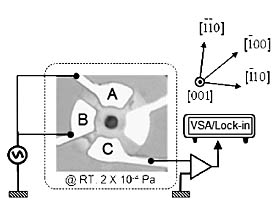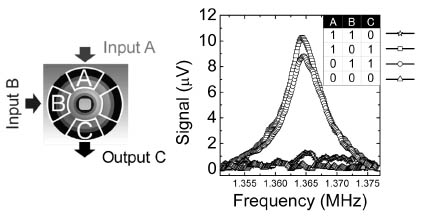Physical Science Laboratory
Membrane-based mechanical resonators (MMR) have received
much interest because they have high quality-factors [1]. In addition,
they also have a large surface area that not only makes them easier to
use in optical architectures, but also it makes them more responsive as
detectors. However, to date most MMRs have been passive structures with
only optical control. The lack of electrical control prevents the development
of the MMR for more practical applications. Here, we report a GaAs/AlGaAs-based
piezoelectric MMR that enables all electrical transduction of the mechanical
motion [2].
The MMR consists of GaAs (5 nm) / Al0.27Ga0.73As (95 nm) / n-type GaAs (100 nm) heterostructure on an Al0.65Ga0.35As sacrifice layer (3.0 µm). The circular membrane with a diameter
of 30 µm was suspended by removing the sacrifice layer through the
center hole with hydrofluoric acid as shown in Fig. 1. All measurements
in this report were performed in a high vacuum and at room temperature.
Mechanical oscillations were induced by applying an oscillating
voltage to electrode A or B due to the piezoelectric effect and the resulting
oscillations were detected by measuring the piezovoltage generated from
electrode C. In order to demonstrate its electromechanical functionality,
a mechanical logic gate is built with the fundamental (0, 1) mode in the
MMR. In the experiment, electrodes A and B are used for binary inputs and
electrode C is used for a binary output where electrodes A and C are along
the [![]() B) logic gate as shown in Fig. 2. Furthermore, we can also demonstrate
an OR (A
B) logic gate as shown in Fig. 2. Furthermore, we can also demonstrate
an OR (A![]() B) logic gate in the first (1, 1) mode using a similar method. Thus, the
electrically-active MMR promises functions and performance beyond conventional
passive MMRs which could be used to develop a broad range of applications
for mechanical resonators.
B) logic gate in the first (1, 1) mode using a similar method. Thus, the
electrically-active MMR promises functions and performance beyond conventional
passive MMRs which could be used to develop a broad range of applications
for mechanical resonators.
[1] J. D. Thompson et al., Nature 452 (2008) 72.
[2] D. Hatanaka et al., Appl. Phys. Lett. 101 (2012) 063102.
 |
 |
|||||
|
|